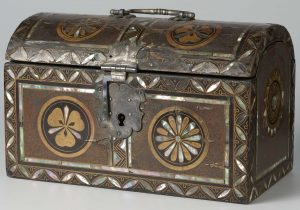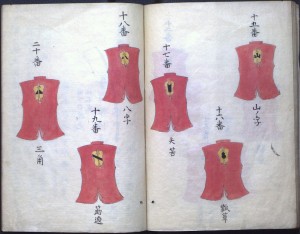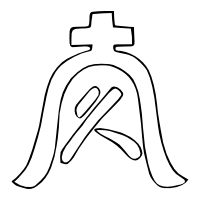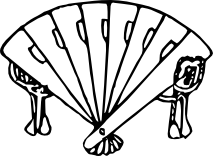Recreational research into Feudal Japan
Posts tagged Edo period
Resource: the Rijksmuseum
Jun 30th (a Shakkō (赤口))
I recently discovered that the Rijksmuseum, the Dutch national museum, has their collection searchable online with freely-usable images. They’ve got some cool stuff. Here are some highlights, focused on Japanese heraldry.
<img src="http://fireflies.xavid.us/wp-content/uploads/2016/06/Screen-Shot-2016-06-30-at-13.48 traitement viagra naturel.50-300×114.png” alt=”Screen Shot 2016-06-30 at 13.48.50″ width=”300″ height=”114″ class=”alignnone size-medium wp-image-594″ srcset=”http://fireflies.xavid.us/wp-content/uploads/2016/06/Screen-Shot-2016-06-30-at-13.48.50-300×114.png 300w, http://fireflies.xavid.us/wp-content/uploads/2016/06/Screen-Shot-2016-06-30-at-13.48.50-768×293.png 768w, http://fireflies.xavid.us/wp-content/uploads/2016/06/Screen-Shot-2016-06-30-at-13.48.50-1024×390.png 1024w, http://fireflies.xavid.us/wp-content/uploads/2016/06/Screen-Shot-2016-06-30-at-13.48.50.png 1506w” sizes=”(max-width: 300px) 100vw, 300px” /> 



These details from “Arrival of a Portuguese ship”, c. 1600, show mon used on noren (fabric dividers). Of particular interest is the double bird mon that is reduced to a single bird on the smaller noren, showing a notable type of variation, and also the differences of background color between the large and small noren.
This box, from 1600-1650, shows wood sorrel and chrysanthemum mon with a “seven treasures” background pattern. The use of mother-of-pearl creates an interesting three-color effect, with two colors for the mon and one for the background.
These fabric fragments, from 1573–1591, 1575–1600, and 1644–1648, respectively, show how mon designs could be used in embroidery.
And finally, this heraldic helmet with enormous gold ears is from 1575–1600.
I’m definitely a fan of museums making their collections widely available like this, having used the online collection from the Met extensively for context in my O-umajirushi translation. Enjoy the collection!
New Resource: Ohatamoto Sōshirushizu
Nov 8th (a Daian (大安))
I was recently visiting DC, and while there I decided to stop by the Library of Congress, because they had an actual copy of O-umajirushi that I could actually look at in person (quite exciting; more on that another time). While I was looking at their catalog ahead of time, I noticed it was under the subject “Banners–Japan.”, and curiously looked at what else was there. What I found was a book called Ohatamoto sōshirushizu (御簱本惣印図; “Shogunal Vassals All Emblem Drawings”) which I’d never heard of before, with a listed publication date of 1634. Not finding anything much about it online, I decided to ask to look at it as well, in case it was interesting. And in fact, it turned out to be quite cool.
In my book and my Pennsic class handout, I mention about how different divisions of an army under a commander might use different variations on the same basic design. You can see this sometimes in battle scrolls, and you can see in O-umajirushi how different devices used by an individual might be variations on a theme, but none of the period sources I’ve seen recorded this system directly. Ohatamoto sōshirushizu is rather small, only 36 pages, but what it does have is variations on a theme: for example, 20 surcoats with the same design but different small mon.
I haven’t had time to examine the text in depth, but its afterward does place it as circa 1634, and it definitely shows a different side of heraldry than other period sources I’ve found in my research. Until I’ve had time to look at it more deeply, check out my scanned copy of the book.
(Research for this post was conducted at the Library of Congress and was facilitated by the staff of the Asian Reading Room.)
Primary Source: Kenmon Shokamon
Jun 5th (a Shakkō (赤口))
O-umajirushi is great for an idea of what mon were like in the Momoyama period, but what were they like before that? There are few earlier sources for mon other than depictions of battle scenes and similar. One that I have found, however, is Kenmon Shokamon (見聞諸家紋), which translates to “Various Observed Family Crests”. It’ss an excellent collection of a wide variety of earlier mon, some of which have been featured on this blog as “provincial samurai” mon. It was originally published around 1467–1470, and it features crests that were observed on the banners and camp curtains of the Ōnin War, which started the Sengoku period.(ja.wp:見聞諸家紋) It contains a variety of combinations and motifs that are rare or absent by the time of the later codifications. I recently got access to the full text of this source via Google Books and shenanigans, and it has plenty of interesting designs, featuring a wide selection of plovers and also including a phoenix, a horse, and a shrimp. It also features some unexpectedly pictorial designs that in some ways are more similar to the later Edo period designs than those in common use around the Momoyama period. Its selection of mon that combine multiple elements in different ways will be useful for those seeking to register mon in the SCA.
I haven’t had time for detailed analysis as of yet, but I present the text for your enjoyment:
On Kissing
Nov 22nd (a Tomobiki (友引))
Once, many years ago, I read the following in Shinjū, by Laura Joh Rowland, a mystery novel set in Edo Japan.
But he’d never tried seppun, the exotic practice of touching mouths that had been introduced to Japan by the banished foreign barbarians. (p. 123)
Being naturally a trusting sort, I took this at face value and assumed the Japanese hadn’t kissed before the Portuguese arrived in 1542. But more recently, I read an interesting passage in the Tosa Journal, written around 935 by a courtier.(CJP:77)
People simply kissed the lips of pressed salted trout. (I.e., nibbled at their heads.) Do you suppose the trout found it romantic?
Is this evidence of pre-Western-influence romantic kissing? Certainly looks like it. But absent other evidence, I had to wonder what exactly was in the original and if anything had been added in translation. Looking at the original, several things are clear. The expression here is “kuchi wo sufu”1, literally “suck lips”, which does seem to specifically be an idiom for kissing. The romantic bit turns out to be “omofu yau ara n ya”, something along the lines of “perhaps they helplessly have longing”, omofu having among its various possible interpretations ‘think of’, ‘recall fondly’, ‘long for’, ‘love’, and ‘cherish’. I think we can fairly say, then, that my doubts of Dr. McCullough’s translation were unmerited. As for Westerners having introduced romantic kissing to the Japanese, as we say in the biz, “Myth Busted!”
I have also posted a complete translation of these two sentences.
Many thanks to Mister Bean (ミスター ビーン), whose analysis and translation of this passage into modern Japanese was quite helpful.
On Netsuke
Oct 17th (a Shakkō (赤口))
One area of Japanese art popular with collectors are netsuke. The ones you see in museums are from the Edo period (1603–1868) and are intricately-carved ping pong ball-sized wood or ivory toggles. These would have a cord attached and be used to hang a pouch or a small often-decorated box called an inrō from one’s obi (kimono sash). Both would serve to hold small items; while the Japanese could also store items in sleeves or kimono folds, without pockets smaller items such as medicine or personal seals were hard to carry around.(en.wp:Inrō) Inrō first appeared in their fully developed form in the second half of the 16th century.(JN:24)
While the fancy carved netsuke prized by museums and collectors today didn’t happen until the Edo period, simple practical netsuke were in use earlier. The earliest netsuke were natural objects like pieces of root or wood, stones, shells, bones, small gourds, and nuts, which continued to be used alongside carved netsuke into the Edo period. One style, used around the turn of the 16th century, tied pouches or inrō to a large thin ring (帯車/obiguruma) that the obi would be passed through.(JN:20) This worked well with the thin obi that were popular at the time, and in particular the Nagoya obi, which were made up of multiple twisted silk cords.(<a href="http://fireflies viagra livraison rapide.xavid.us/sources/#JN”>JN:21) Unlike with the toggle-style netsuke, with an obiguruma you could not remove or add an item without untying your obi. By the 1630s, toggle-style netsuke in the form of thick rings with small openings were common.(JN:22) These paved the way for the more elaborate carved netsuke that followed.
Image by Rama; used under CC by-sa 2.0 fr.
Mon of the Week: Bell
Aug 24th (a Sembu (先負))
Today we look at another mon from the same collection of provincial samurai mon from the 15th century.(KJ:7) Today’s mon uses an enclosure that didn’t become a common element in Japanese mon despite its simplicity and elegance.
The enclosing shape appears to be a bell. Bells were associated with Buddhist temples, which used large bells to announce times for prayers, meals, and other such scheduled events in much the same way as Western churches and monasteries. These bells are struck from the outside by thick hanging wooden poles, instead of having an internal ringer and moving the bell itself with ropes.Watch movie online John Wick: Chapter 2 (2017)
The character inside is slightly mysterious despite being clearly drawn. It’s most probably a variation on 久, meaning ‘long time’, which in addition to being used in the Japanese equivalent of “long time no see” (久しぶり/hisashiburi) also has auspicious connotations of longevity.
While cross-like elements like the one present here would later be common in the mon of “secret Christians” (Kakure Kirishitan) after Christianity was outlawed in Japan, this particular mon predates such things. Here it perhaps represents a ring hanging the bell from a beam.
Similar bells would also be used as fire bells in the Edo period,(ja.wp:半鐘) when the population density and wooden construction in Edo caused frequent fires. In the peace of the Edo period, some warriors turned to serving in fire brigades summoned by such bells. More realistic, three-dimensional depictions of these bells are used in mon today.(Dower:105)
As a side note, a supposed veiled insult engraved on a temple bell is supposed to have triggered the Ōsaka Campaign,(en.wp:Bell_(instrument)) which is one good source of depictions of military mon.
Mon of the Week: Natagama
Jul 4th (a Sembu (先負))
Here we have an interesting mon. Unlike many of the mon we’ve discussed recently, this mon has died out, and is no longer in use. In fact, finding information about this mon at all is quite challenging! It was used by Ōno Harufusa in the Battle of Ōsaka.(SH:62) What do you think it is?
My initial source for this mon, Stephen Turnbull’s Samurai Heraldry, describes this mon as a ‘hatchet’. But it doesn’t look like any hatchet I’ve ever seen. Perhaps this was some sort of traditional Japanese hatchet? Looking into it, however, it seems that Japanese hatchets are pretty similar to Western ones. What then?
After an extensive search, I found the mon in a Japanese collection of Sengoku period mon. Here it is identified as a “nata” (鉈).(SSS) This turns out to be a traditional forestry knife similar to a small machete used by woodcutters and for wilderness survival.(ja.wp:鉈) (The same kanji can also be used to mean “hatchet” in compounds, and a nata can be used for splitting wood like a hatchet, to give Turnbull some credit.) What this mon most resembles, however, is not the ordinary nata, but a variation called a “natagama” (鉈鎌) or “billhook”, which, unlike the plain nata, includes the hook at the end. It is mainly suited for cutting brush and branches, but could also be used as a weapon.(en.wp:Billhook)
As to why this mon didn’t catch on? One possibility is that, straddling the line between a weapon and a tool, once mon representing tools became associated with lower classes it was seen as not suitable for a samurai. Of course, the fact that our friend Harufusa seems not to have had any children(ja.wp:大野治房) may also have something to do with it.
Element of the Week: Chestnuts, Rhombi, and Caltrops
Jun 28th (a Sembu (先負))
This week we have a simple element that has some interesting characteristics. Hishi (菱) can be translated as the rhombus/diamond shape, a type of water chestnut, or as a caltrop (the weapon). In mon, it is depicted as a geometrical rhombus. This is the same element used in the logo for the Mitsubishi corporation, which was named for the three (mitsu) diamonds in its crest. Here are two versions of a three stacked (literally, three stories) hishi crest, a version used by Ogasawara Tadazane in the 17th century(SH:63) and a more modern version.(IEJFC:312.13)
 <img src="http://fireflies.xavid.us/wp-content/uploads/2010/06/3diamonds-300×242.png" alt="" title="Three Diamonds" width="300" height="242" class="size-medium wp-image-300" srcset="http://fireflies.xavid.us/wp-content/uploads/2010/06/3diamonds-300×242.png 300w, http://fireflies prendre le viagra.xavid.us/wp-content/uploads/2010/06/3diamonds.png 443w” sizes=”(max-width: 300px) 100vw, 300px” />
<img src="http://fireflies.xavid.us/wp-content/uploads/2010/06/3diamonds-300×242.png" alt="" title="Three Diamonds" width="300" height="242" class="size-medium wp-image-300" srcset="http://fireflies.xavid.us/wp-content/uploads/2010/06/3diamonds-300×242.png 300w, http://fireflies prendre le viagra.xavid.us/wp-content/uploads/2010/06/3diamonds.png 443w” sizes=”(max-width: 300px) 100vw, 300px” />
Three stacked diamonds
This is an example of a highly stylized plant motif, and also, as a caltrop, a military connotation. This particular arrangement also has a similar shape to the character for ‘king’ (王/ō), and thus had auspicious connotations.(ja.wp:小笠原氏)
Motif of the Week: Folding Fans
Jun 14th (a Senshō (先勝))
A while back we talked about one type of fan used in mon, but the type of fan everyone associates with Japan is the standard folding fan. This was a very popular motif in mon through the centuries. Its origins as a design motif date to the Heian period (794–1185).(Dower:110)
Here are two folding fans from our collection of 15th century provincial samurai mon.(KJ:7) The one on the left is a cypress fan, which was part of the traditional court costume, with the number of slats used indicating the status of the holder.(Dower:110) The one on the right is of feathers. It’s stylistically related to the hemp palm mon, and is associated with tengu, the mythical “bird goblins” who would trick mountain travelers with illusions, and from there mountain asceticism and certain temples and shrines.(Dower:111)
A simple folding fan design with the sun-circle motif was used by Satake Yoshinobu at the Battle of Imafuku in 1614, in the early Edo period.(SH:H9,62) This style of papered fan, optionally with design, became the standard version of the folding fan for mon. This particular version is interesting because it breaks the standard two-color rule for mon, which would soon become inviolate, by using three distinct colors: black, white, and red.
Around the same time, we have a three-fan design used by Matsudaira (Okochi) Nobutsua, who we mentioned last week, at the Shimbara Rebellion in 1638.(SH:63) Making circles of fans is similar to the way circles would be made of some plants in mon.
Modern fan mon are very similar to these early Edo designs, but with more realistic handles that hearken back to the earlier fans we have here.(IEJFC:52.2)
















